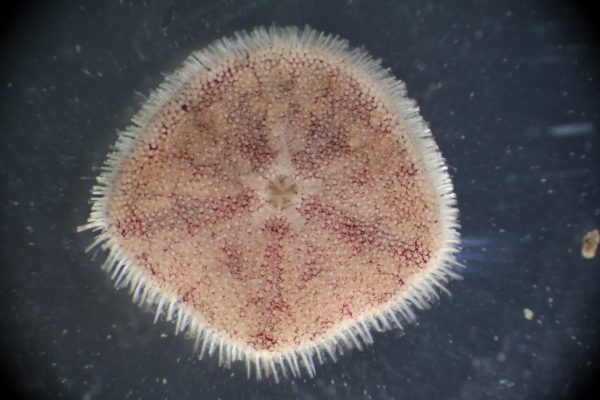Relatively Speaking

Though it will not show up in any Ancestry.com profile, and even Henry Louis Gates, Jr. would be unable to find it in our roots, we and the humble sand dollar are related – sort of.
Prized by beachcombers the world over, the sand dollar (in fact, all echinoderms) share a deep evolutionary ancestor with we vertebrates.
In fact, by examining the evolution of sand dollars, mythically referred to as “Mermaid Coins,” we may gain insight into our own potential to control how we develop, grow, and heal.
“We have a lot to learn from echinoderms. Echinoderms can regenerate all their tissues even as adults, and somehow most vertebrates have lost that potential said Dr. Dan Janies, a professor at UNC Charlotte’s College of Computing and Informatics (CCI).
To do so, Janies joined forces with a team of experts to complete the first mitochondrial genome of a miniaturized echinoderm, Sinaechinocyamus mai (pictured), and identify its place in the tree of life.
“Our colleagues at the National Taiwan University (Jih-Pai Lin, Mong-Hsun Tsai, Lo-Yu Chang, Kuan-Ting Lin, Shyh-Jye Lee) acquired some specimens of Sinaechinocyamus mai and had genomes sequenced,” said Janies. “This project presented several challenges. First, the Sinaechinocyamus mai is very small (e.g., the specimen pictured is only 6.5 mm, or a quarter of an inch in diameter). Second, the raw echinoderm DNA data was mixed with foreign DNA.”
In response, Janies’ CCI team, including graduate student Aaron Trautman; post-doctoral fellow, Denis Jacob Machado and research assistant professor Robert Reid from the Bioinformatics Research Center at the North Carolina Research Campus used open source and in-house software to separate pure sand dollar data from the raw data.
With echinoderm data in hand, the team needed to see where the species best fits in the tree of life. With collaboration from Omri Bronstein and Andreas Kroh with The Natural History Museum of Vienna the team wrangled additional data from several other mitochondrial genomes.
“From this,” said Janies, “we were able to place Sinaechinocyamus mai as a member of the sand dollars who are flattened and, in this case, miniaturized relatives of sea urchins. Other examples of miniaturized echinoderms include the enigmatic starfish species Xyloplax spp. These miniaturized echinoderms demonstrate that even after hundreds of millions of years of evolution the echinoderm life cycle can evolve and the the body plan has not been frozen from further change.”
Unlike us, echinoderms are five- (or more) sided, exclusively marine, can regenerate their tissues, and have a complex life cycle that often is truncated into tiny juvenile forms that have adult reproductive capacities, a process called progenesis.
“We do not yet know the genomic underpinnings of progenesis,” said Janies, “but we have some clues that changes in genetic circuitry leads to differences in skeletogenesis in various forms of sea urchins.”
If, as the work of Janies’ team suggests, sand dollars are capable of progenesis and we share a distant genetic relationship, we may learn something about our quiescent regenerative powers by unlocking their secrets.
“This is why we study the natural world and its organizing principles,” said Janies. “Once we establish principles,” he said, “I think we can begin to move forward in discovering practical applications. There are many examples of how our freedom to do basic research leads to applied benefits. One of the best examples is the discovery of the green fluorescent protein (GFP) of jellyfish. Initially, GFP was just a curiosity. Now, GFP has been leveraged into an industry that serves biomedical research in cancer, reproduction, and infectious disease.”
To read the original article about this work, CLICK.
Photo Credit: Jih-Pai Lin
For more News, Notes and Updates, Follow Us on TWITTER.